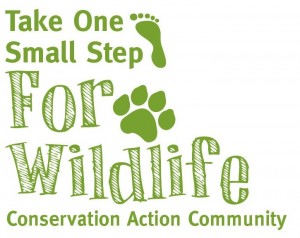By Roger Williams Park Zoo
Many of us want to do our best to help the environment and wildlife, but with so many suggestions on what to do — grow your own garden, drive a hybrid car, carry recycled bags, etc. — it is easy to feel overwhelmed and find yourself doing nothing! Additionally, many of us try out these new initiatives, only to find ourselves drifting back to our old, familiar ways after a few weeks.
 It might surprise you, but even the staff and volunteers of the Roger Williams Park Zoo have a hard time changing habits for the better. However, we understand that the survival of wildlife depends on us, and it’s vital that we keep trying to live better. That’s why we’ve decided to take one small step for wildlife, and we want you to do the same!
It might surprise you, but even the staff and volunteers of the Roger Williams Park Zoo have a hard time changing habits for the better. However, we understand that the survival of wildlife depends on us, and it’s vital that we keep trying to live better. That’s why we’ve decided to take one small step for wildlife, and we want you to do the same!
What does taking one small step for wildlife mean? Instead of trying to adopt every environmentally responsible behavior that crosses your path, you commit to one conservation initiative for the year. Throughout that year, it is important to remember that it takes time to create healthy habits and that you may falter at times. But this initiative isn’t about being perfect; it’s about moving forward.
The small step we are choosing for 2010 is to reduce our water use by taking a 5-minute shower.
I know what you’re thinking: A 5-minute shower sounds militant. Many of us feel long showers are a deserved luxury, our time to unwind and reflect. But many animals rely on that same water supply, not for enjoyment, but for survival. All the water in our area, whether it comes out of your faucet or runs through the local stream, is connected underground in a water table. When people use excessive amounts of water, it can drain the water table.
This drop can affect water levels in habitats that are miles away. Low water levels in habitats can decrease an animal’s ability to find food, to make a home, and to reproduce. Locally, our water habits affect wildlife like raccoons and the great blue heron, just to name a few.
In addition to helping keep local waterscapes healthy, reducing your shower time can also reduce your energy bill! Environmentally and economically responsible? What are you waiting for? Pledge to take one small step for wildlife today!
For more information visit the conservation page on the Roger Williams Park Zoo website.
ACTIVITY: We’re all in this together!
Materials:
- Shower Coach or other timing device
- Paper and pencil to create a family log
The purpose of this activity is for your family to work together to achieve water conservation success! As a family, discuss the importance of water conservation. You may even want to visit a local waterscape and make a list of all the animals you see that rely on that habitat for survival. A great one is the wetland trail at Roger Williams Park Zoo.
Next, multiply 5 minutes by the number of members in your family. This is the total number of shower minutes (or less) that your family is striving to use each week. As a family design a fun graph or chart where each member can record his/her minutes.
At the start of a new week, begin using the Shower Coach or other timing device to measure the length of your showers. Remember, as a family this is your shower minute allotment. If someone goes over 5 minutes, someone else may have to shower less than 5 minutes for your family to meet its goal. You’re all in this together! Make it fun and encourage one another.
At the end of the week, assess how you did. Even if you don’t hit your ultimate goal, it is valuable to consistently try to shorten the amount of time your family spends in the shower. Again, it’s not about being perfect, it’s about moving forward. Find a way to celebrate your family’s success — a walk outside, ice cream in the park, a trip to the Zoo!
At the start of the following week, make a new chart and try again!









What a great way to teach young kids about basic math and water conservation. Thanks for the suggestion.